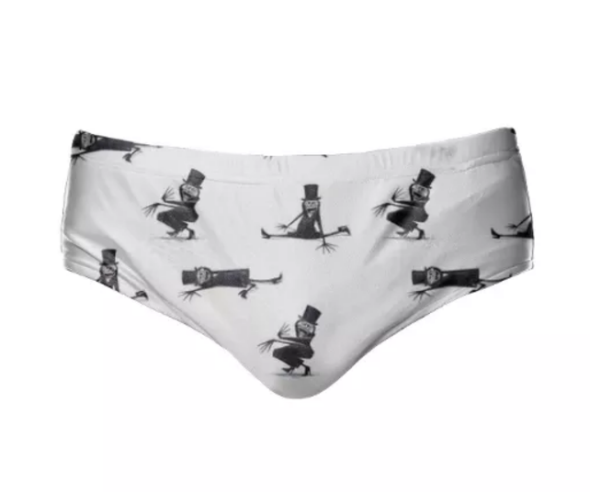I know you thought you were done with the Babadook after we left him safely tied up and munching earthworms in a basement at the end of the eponymous 2014 Australian horror film—but, honey, you were wrong. You see, it’s LGBTQ Pride season in much of the world, and our top-hatted, long-nailed, pop-up book-crafting terror of a friend isn’t going to miss out on the festivities, oh no.
In fact, over the past week or so, a meme built around the notion that the Babadook is gay has captivated the (queer) internet, spawning a delightful rash of fan art, Twitter jokes, and apparel—the apotheosis of which might be this voguing Babadook speedo.

Phillip Orozco/Paom.com
So how did a character who was pretty clearly a metaphor for a widowed mother’s grief and depression become, as he is now being touted, an LGBTQ icon? I first encountered the meme via deaconess of gay Twitter (and Outward contributor) John Paul Brammer back in February and have been giggling quietly to myself about it a few times a week ever since.
But others have traced it back to a cluster of events from the fall of 2016, when a Tumblr user uploaded an image of their Netflix interface seeming to show the film mistakenly (???) categorized as “LGBT” and commented “So proud that Netflix recognizes the Babadook as gay representation.” The notion was popular among commenters:
Ianstagram: Whenever someone says the Babadook isn’t openly gay it’s like?? Did you even watch the movie???
Necromantics: It’s canon basically. I mean he created a pop-up book of himself for the drama of it all???
And it continued to spread over the next few months:
But it really took off at the start of Pride in June:
Understanding the genealogy of the meme is all well and good, but that doesn’t really account for its wild popularity. Why does the concept of a queer Babadook delight so many, including myself, to the point of 😭😭😭.
There are those who’ve attempted a cultural studies-type “queer reading” of the film itself, locating in the Babadook’s struggle for self-assertion amid a straight household a version of the queer coming out narrative. Except, of course, in this case, the thing coming out is a demonic manifestation of mental illness. I reckon these things are never quite one-to-one?
More compelling to my mind is to consider the figure of the Babadook himself and how he perfectly activates a network of queer cultural impulses that run deep in our collective psyche. A clear place to start is with camp sensibility, which I think of as viewing the “wrong” details and nuances of a given cultural object as more pleasing than the ones the creator meant to foreground. The Babadook is meant to be a child’s imagining of menace and terror; after all, he eventually forces a mother to attempt to murder her own son. But what if, instead of all that, we were just really into his shift dress/trench coat moment? And his bendy, sort of mincing comportment, especially in the illustrated portraits? A top-hat is a sure, if somewhat easy, route to a cute outfit, and all that “dook-dook-dook”-ing while resembling a particularly scruffy Mr. Hyde is sort of weird-sexy, right? Surprise, bitch! Your picture book is possessed!
With the help of camp, queers have long made a habit of appropriating and adapting straight cultural products (which historically excluded us) for our own enjoyment. This is especially true of works involving darkness, pain, and horror: See, for example, Darren Aronofsky’s Black Swan (which has become part of the midnight screening repertoire), or, my personal favorite, the Hellraiser series. This connection arises from a perverse sort of simpatico: Queer people have long been demonized by Anita Bryant-types as horrific aberrations, a dark force working to corrupt the polished sanctity of the heterosexual family. Is it any surprise, then, that we find ourselves somehow at home in fractured minds and disquieted basements, among the wreckers and the rot?
That feeling of exclusion, as it festers, can lead to a certain glee taken in what I think of as queer cultural terrorism: the aggressive hijacking or cooption of straight culture in a manner meant to tweak or antagonize. I confess to undertaking a bit of this in my camp take-down of Gravity, that uber-serious and utterly ridiculous space romp from a few years back. Entire religions have been subject to the same treatment. The Babadook himself acts as a queer terrorist (in a Victorian banshee kind of way), raining havoc on the moral seriousness of love, both between a (recently broken) heterosexual couple and a mother and her child. That the film’s somber ideology encourages a hostile response, especially while its supposed villain basically enacts one, makes identifying with the Babadook that much easier.
If that seems overly nasty, know there’s a spirit of celebration in the mix as well. Queers have a way of effervescing around the objects and figures we claim as our icons, often to an excessive degree. Cults of diva worship are founded on this, and the skill with which we can recite chapter and verse from our camp-captured movies arises from it as well. The Babadook—whether misunderstood “stunt queen,” valiant queer terrorist, or both—is simply the most recent addition to our reliquary.
As such, don’t be surprised when you see him honored this Pride season. I, for one, have already taken steps to ensure that I can work an appropriately adulatory babalewk.
